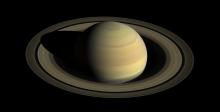Listen to today's episode of StarDate on the web the same day it airs in high-quality streaming audio without any extra ads or announcements. Choose a $8 one-month pass, or listen every day for a year for just $30.
You are here
Winter Preview
Summer ended less than a week ago, but you can already get a preview of the evening skies of winter in the hours before sunrise.
Winter’s evening-sky highlights include the constellations Orion and Gemini, along with Sirius, the brightest star in the night sky. All of them are in view by about 4 a.m., and are high in the sky at first light.
Orion is in the south and southeast as dawn breaks. It’s best identified by the hunter’s “belt” of three fairly bright stars. The brightest stars in the constellation flank the belt: orange Betelgeuse to the upper left, and blue-white Rigel to the lower right.
Orion’s Belt points the way to Sirius. Just follow its line toward the lower left and you’ll come across the brilliant star. It’s in Canis Major, the big dog, so it’s also known as the Dog Star. Because Sirius is so bright, it twinkles more than most other stars. It switches from white to red to blue in the blink of an eye.
Gemini is well to the left of Orion. It’s noted for the bright stars Castor and Pollux, which represent the heads of the celestial twins. Pollux is the brighter of the two, and has a definite orange hue. Castor is above it.
As Earth moves along its orbit around the Sun, all these beautiful sights rise a few minutes earlier each night. So in a few months, they’ll highlight the evening sky — putting on a strong showing throughout the long, cold nights of winter.
Tomorrow: continuing the search for aliens.
Script by Damond Benningfield






